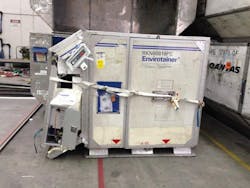Are You Taking Responsibility For Safe and Effective ULD Operations and Handling?
Airlines today often find themselves between a rock and a hard place, on one hand they have very little control over the manner in which their unit load devices (ULD) are being handled and operated, yet on the other hand they risk being sanctioned by the aviation authorities for failing to ensure that the aircraft is loaded in strict accordance with the Weight and Balance Manual which, from a ULD point of view, means that only airworthy ULD that have been properly built up make it onto the aircraft.
There are also commercial issues here: nobody is very keen to reject a pallet load of cargo at the door of the aircraft because the ULD is found to be in a non-airworthy condition, the temptation is to turn a blind eye, further, to be fair to the ground handlers, today's large wide-body aircraft carry more than double the number of ULD than aircraft such as the A300, A310 and 747-100, all being loaded during the same rushed turnaround and probably with fewer people, isn't this an accident waiting to happen?
It would be inappropriate to single out any particular party to be at fault here, as the roots of this particular situation extend in many different directions and involve different parties and for changes to be made it will require a coordinated and industrywide willingness to address the subject.
First of all, it is no secret that the highly competitive ground handling industry environment has enabled airlines to achieve lower and lower handling rates, and of course in such a situation there is little incentive to invest in ULD infrastructure and ULD training, both of which are essential for safe ULD operations. This is not to say that every airline takes this approach, nor is it to say that every ground handler or cargo terminal is deficient in either infrastructure or training or both, but it is probably fair to say that the industry average falls far below acceptable levels. The counterpoint to this scenario is that ULD owners are spending in excess of $300 million USD every year on generally unnecessary repairs, not to mention the cost of aircraft damage, delays, etc.
How do the airlines fit into this equation?
Well, in addition to extracting unrealistic handling rates, it is also probably fair to say that after years of outsourcing much (if not all) of their ULD handling and operations to third parties, most airlines have lost the knowledge of what constitutes proper ULD handling; indeed this situation gets worse by the year as more people retire from this industry.
We must add into this rich mixture both technology and industry trends. Technology in the form of lighter ULD is a trend driven by the airlines' needs to reduce dead weight in the aircraft, both for fuel burn and range reasons. Today's typical large wide-body aircraft such as a 787-900 is carrying 1600 Kg of ULD “tare weight” requiring 60+ Kg of fuel over a 10-hour flight or 25 tons over a typical year’s operation. While ULD designers of course do their very best to maintain durability while reducing weight, nevertheless a lightweight ULD will not respond very well to being mishandled by forklifts or dropped off of a dolly! Surely it's in the long-term interests of both airlines and ground handlers that new technologies such as lightweight ULD can be successfully introduced, delivering lower costs to airlines and perhaps improved rates to ground handlers?
This might appear to be a rather gloomy outlook, what's it going to take to trigger some significant changes to the way things are being done today?
Fortunately some help is already in place; back in 2010, IATA repositioned ULD within the IATA Cargo area and allocated a significant increase in resources. This action resulted in the publication of the IATA ULD Regulations (ULDR) in January 2013, certainly the “go-to” source of information for any organisation working with or around ULD. The ULDR defines the responsibility of and provides a foundation for the service providers, and through standardisation, facilitates the development of training materials. And talking of training, or the lack of training, as raised in the previous article there is a serious misconception that the folks who load and dispatch ULD day in and day out do not require training. Today this has become a Catch-22 situation, the handling industry gets by without training and so the training industry sees no reason to provide convenient ULD courses, so nobody gets trained … round and round we go! IATA has taken the important step to expand its Accredited Training School scope to include ULD training in recent months. This is a huge step forward as the ATS system can provide training in local language at convenient locations and also is now offering five-day ULD “ Train the Trainer” courses for organisations who intend to set up ULD training capability.
ULD industry group ULD CARE is also not sitting still. During Q3 2016, this organisation will launch a book, “ULD Explained,” which is targeted at the “ULD novice” or for that matter the person who may have worked with ULD for many years but who has never had access to any written instructions, relying instead on word-of-mouth advice. ULD CARE is also in the process of launching a ULD Code of Practise, a concise and simple-to-understand document that it is hoped the industry will adopt as a standard for ULD operations wherever they take place.
And, the “ULD conversation” is slowly expanding its range, reaching out to the freight forwarders, airports and indeed any organisation that has direct or indirect involvement with ULD, it will need everyone to become more aware of the importance of ULD to a sustainable airline and air cargo industry before change will really happen, and change is certainly needed!
Readers may imagine that the ULD scene is pretty static, after 40+ years what more is there to come from such an apparently simple device? This would be incorrect, to mention just two aspects. The first is the tremendous growth in the transport of pharmaceuticals by air, requiring very exact temperature control. The active temperature controlled containers (TCC) that these days can often be seen around airports are extremely costly and contain sophisticated cooling, heating, power and control systems. TCC require both proper attention to their operation as well as careful handling if they are not to be damaged. The second is the whole subject of fire containment covers and fire-resistant containers. These devices are designed to be able to contain lithium battery fires for a period of six hours, enabling the aircraft to get safely to an airport. Without such devices, the flying time after fire detection is measured in minutes not hours. FCC and FRC are already in service with some airlines as part of a lithium battery fire risk mitigation process, with other airlines in the pipeline, thankfully there have not been any major incidents with lithium battery fires in the past couple of years, but the risk continues to be as high as ever.
The air cargo industry needs to be able to carry perishables and lithium batteries in a safe and efficient manner, and to do so requires the ground handling industry to raise their game when it comes to working with the special ULD that are required for such shipments.
We hope these two articles on ULD will have provided readers with some useful insights into the world of ULD. Next time you are out on the ramp and see a dolly train going by on its way to the aircraft or are beside a cargo terminal and see a load of stored ULD perhaps, having read these articles, you may give them a second glance and ask yourself, are those ULD airworthy, or are they stored correctly?
About the Author

Bob Rogers
Bob Rogers has spent most of his working life in Asia Pacific, resident in Hong Kong and for many years running the Asia Pacific operation of Nordisk Aviation Products. Mostly retired from a demanding “ day job” these days he remains actively involved in promoting and supporting a wider understanding of ULD through his involvement with IATA and ULD CARE.
